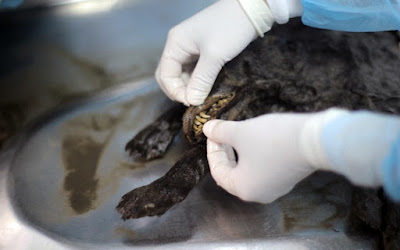Yahoo – AFP,
Maria Antonova, 28 March 2016
 |
A scientist
performs an autopsy of the remains of a puppy, which died 12,460
years ago and
was discovered in Russia's northern Yakutia, at the North-Eastern
Federal
University in Yakutsk (AFP Photo)
|
Moscow
(AFP) - The hunters searching for mammoth tusks were drawn to the steep
riverbank by a deposit of ancient bones. To their astonishment, they discovered
an Ice Age puppy's snout peeking out from the permafrost.
Five years
later, a pair of puppies perfectly preserved in Russia's far northeast region
of Yakutia and dating back 12,460 years has mobilised scientists across the
world.
"To
find a carnivorous mammal intact with skin, fur and internal organs -- this has
never happened before in history," said Sergei Fyodorov, head of
exhibitions at the Mammoth Museum of the North-Eastern Federal University in
the regional capital of Yakutsk.
 |
The
discovery of 12,460-year-old puppies
in Russia could contribute to the lively
scientific debate over the origin of
domesticated dogs (AFP Photo)
|
When the
hunters stumbled on the first frozen pup in 2011, they alerted Fyodorov who
immediately flew out to the remote Arctic tundra, about 4,700 kilometres (2,900
miles) from Moscow and only 130 kilometres from the Laptev Sea, which borders
the Arctic Ocean.
Last year
he returned for a more thorough look and found the second puppy close to the
same spot, farther down the slope. Both had died when they were about three
months old.
They most
likely come from the same litter, said Fyodorov.
Last week
he oversaw the removal of the second puppy's remarkably well-preserved brain --
"the first in the world", he said.
"Puppies
are very rare, because they have thin bones and delicate skulls," he said.
The duo
have been named the Tumat Dog, after the nearest village to the site.
Fyodorov
said a preliminary look at the mammoth remains also found at the dig suggested
some had been butchered and burned, hinting at the presence of humans. It
remains to be seen, however, whether the puppies were domesticated or wild.
The answer
can only be determined by reconstructing their genomes, which would take at
least a year.
Grass-eating dogs?
"Thus
far, the lineages of wolves that likely gave rise to dogs have not yet been
discovered and it's possible that these puppies could be on that lineage, which
would be very exciting," said evolutionary biologist Greger Larson of
University of Oxford, one of the scientists behind a collaborative project
aimed at finding out when and where dogs became the first domesticated animals.
 |
Scientists
from the Mammoth Museum of the North-Eastern Federal University
extract the
brain of a puppy, which died 12,460 years ago and was discovered in
Russia's
northern Yakutia (AFP Photo)
|
What makes
the dog particularly intriguing is that it managed to become "man's best
friend" even before humans became settled farmers.
It is still
unclear whether dogs were domesticated in one place or in several places
independently, and whether the process started when humans took in cubs or
whether wolves themselves gradually drifted to human sites in search of food.
Whatever
their precise lineage, the Tumat pups will keep Fyodorov and other scientists
busy for some time.
The second
puppy's preserved brain will be compared with that of modern dogs and wolves.
Parasites found on its body will be analysed, as will the contents of its
stomach, which Fyodorov is particularly excited about.
"When
we opened it, we were very surprised. The second puppy's stomach is mostly full
of twigs and grass," he said, wondering if perhaps the animals were not
exclusively carnivorous or whether they started eating grass after they were
trapped by a mudslide and began to starve.
"This
material is really exceptional and unique," said Mietje Germonpre, a
palaeontologist from the Royal Belgian Institute who partnered up with Fyodorov
on the project and came to Yakutsk to oversee the autopsy of the second puppy
earlier this month.
"The
fact that soft tissue is preserved will give much more information compared to
information that can be obtained from 'normal' fossils," she said, meaning
bones and teeth.
 |
Graphic on
the origins of the domestic dog (AFP Photo/Adrian LEUNG, John SAEKI)
|
Permafrost secrets
Fyodorov
lamented the long time it takes to get ancient biological material to suitable
labs due to financial constraints, the rugged terrain and red tape which
sometimes means that samples reach laboratories only six months later.
"Everyone
understands that the tissue of mammoth fauna loses its structure with every
passing second, even in the freezer," he said.
Yakutia's
melting permafrost is likely to yield up even more treasures in the coming
years, he added, saying the number of reported prehistoric finds has grown
"severalfold" in the last decade.
Warm and
wet weather and flash floods have been a big contributor to the thaw, he said.
"Right
now it's 0 degrees (Celsius) here. That should not be the case in March."
As better
transport and technology becomes affordable, he said, locals are embarking on
expeditions to more and more remote corners of Siberia to look for the precious
and lucrative mammoth tusks, which can sell for tens of thousands of dollars
and are increasingly prized by Chinese carvers given trade bans on elephant
ivory.
In Russia,
indigenous tribes are allowed to hunt for ancient remains on their ancestral
lands.
"Our
land is locked in by permafrost, but little by little it is revealing its
secrets," Fyodorov said.
Related Article:


No comments:
Post a Comment